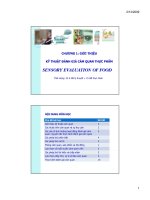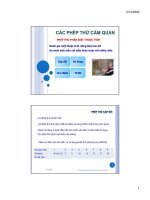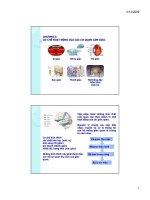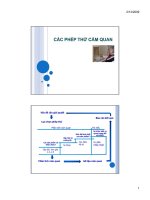Organic food
Bạn đang xem bản rút gọn của tài liệu. Xem và tải ngay bản đầy đủ của tài liệu tại đây (461.66 KB, 15 trang )
Organic food
Kadri Kalle,
Sustainable
SCANdinavia
What is organic food?
Organic food is a product of a farming system that uses natural and regenerative processes:
• crop rotation;
• animal and plant manuring;
• mechanical weeding;
• biological pest control.
It refrains from the use of any toxic chemicals.
Organic animal feed and welfare standards are important.
In organic farming:
NO:
artificial fertilizers
synthetic pesticides
GMO
growth regulators
artificial feed additives
antibiotics are not preventively used on animals
Animal welfare
spacious and comfortable environment;
access to open environment;
quality feed such as grass pastures for livestock;
relief from mental stress caused due to electric fence etc.
Why organic?
The mission of agriculture is not only to produce enough food, but also to take
account the effects to the:
environment;
human health;
animal welfare;
social and regional development.
Benefits
Positive effect to biodiversity;
Fewer contaminants (such as pesticides, antibiotics and nitrates);
Scientific studies have shown, there are more vitamins and minerals in
organically produced food:
◦
In organic milk, more antioxydants, 50% more of vitamine E, beta-carotene.
Comaparison made in Denmark
Problems of intensive farming
pesticide residues in products, soil, water;
fertilizers (eutrophication);
loss of biodiversity- kills both harmful and beneficial organisms, destroys
habitations of species;
degradation of soils (erosion);
landscape changes.
Financial aspect
INRA and CNRS French scientists and a UFZ German scientist found that the
worldwide economic value of the pollination service provided by insect
pollinators, bees mainly, was €153 billion in 2005 for the main crops that
feed the world.
This figure amounted to 9.5% of the total value of the world agricultural food
production.
The study also determined that pollinator disappearance would translate into a
consumer surplus loss estimated between €190 to €310 billion .
( “Ecological Economics”)
Pesticides
Every year in EU, around 200 000 tonnes of pesticides are taken to environment.
In last 10 years, the amounts have doubled.
Most of the pesticides in the top 10 of residues in EU have been declared dangerous to
human health by WHO.
In many cases, they are dangerous both to health and environment
◦
(water, soil, air pollution, negative impact to birds, bees, fish, instects etc)
Pesticides
Possible effects: poisonings, allergies, headache, impact on fetus, genetic
changes, negative impacts on hormonal system and reproductive organs.
The co-effects of pesticides are unknown, due to coctail-effect the effect of
many pesticides could double or triple.
Pesticide residues with certain molecule mass can accumulate in liver,
bones, fat tissue.
New pesticides are being taken to use all the time, while the old ones still
remain in the environment.
Pesticides
In Estonia in 2005, different fruits
were tested for pesticide residues:
◦
◦
◦
◦
◦
Grapes – 8 different residues
Orange, tangerine, paprika, pear, tea – 7 different residues
Lemon, peach – 6 different residues
Most of the residues are found in the peel
Orange, kiwi, tea, peach – level of pesticide residues more than allowed
In UK, apples could be sprayd 16 times with 36 different pesticide.
(Heaton, 2001)
Critics of comparisons
(Williams et al 2000 )
Food is complex topic
In order to compare, the food has to come from similar conditions.
Small differences in the level of vitamins might not have considerable impact to
health.
The amount of nutriens in food are influenced also by other things besides way
of farming.
Food and sustainability
Sustainable food?
- food, that is healthy both to Earth and everyone living on it
◦
◦
◦
Local economy
Protection of ecosystems
Quality and healthy food
Principles:
◦
◦
◦
◦
◦
◦
Local food instead of imported
More vegan products than animal products
Certified organic food
Fair trade products
Minimal packageing or reusable packages
Healthy food
(Sustainable Food Guide):
How to recognise?









